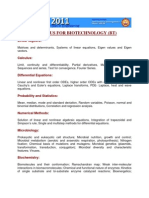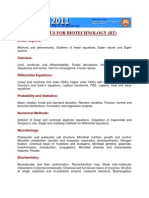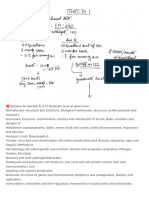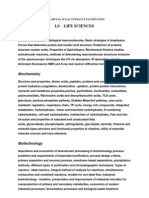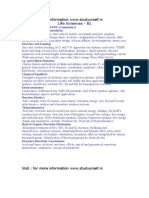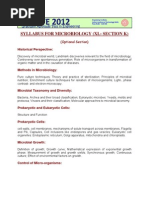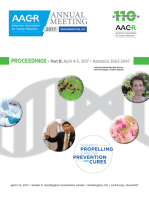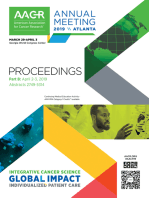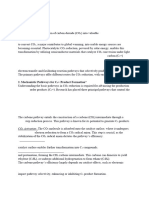0%(1)0% found this document useful (1 vote)
260 viewsEntrance Test Syllabus For M. Tech (Pharma. Biotechnology) (ICT Admission 2016-17)
Entrance Test Syllabus For M. Tech (Pharma. Biotechnology) (ICT Admission 2016-17)
Uploaded by
अनिकेत भगतThe document outlines the syllabus for the M. Tech. Pharmaceutical Biotechnology Entrance Examination at the Institute of Chemical Technology in Matunga, Mumbai. The syllabus covers topics in microbiology including microbial taxonomy, eukaryotic microorganisms, and viruses. Biochemistry topics include the study of carbohydrates, lipids, proteins, nucleic acids, enzymes, and thermodynamics. Molecular biology concepts such as recombinant DNA technology, genetic systems, and PCR techniques are also included. The syllabus examines fermentation and bioreactors, tissue culture techniques, biologicals and biopharmaceuticals production, and analytical methods for analysis of biologicals. It concludes with applications of biotechnology in pharmaceuticals and food.
Copyright:
© All Rights Reserved
Available Formats
Download as PDF, TXT or read online from Scribd
Entrance Test Syllabus For M. Tech (Pharma. Biotechnology) (ICT Admission 2016-17)
Entrance Test Syllabus For M. Tech (Pharma. Biotechnology) (ICT Admission 2016-17)
Uploaded by
अनिकेत भगत0%(1)0% found this document useful (1 vote)
260 views2 pagesThe document outlines the syllabus for the M. Tech. Pharmaceutical Biotechnology Entrance Examination at the Institute of Chemical Technology in Matunga, Mumbai. The syllabus covers topics in microbiology including microbial taxonomy, eukaryotic microorganisms, and viruses. Biochemistry topics include the study of carbohydrates, lipids, proteins, nucleic acids, enzymes, and thermodynamics. Molecular biology concepts such as recombinant DNA technology, genetic systems, and PCR techniques are also included. The syllabus examines fermentation and bioreactors, tissue culture techniques, biologicals and biopharmaceuticals production, and analytical methods for analysis of biologicals. It concludes with applications of biotechnology in pharmaceuticals and food.
Original Description:
Syllabus for M.tech pharma ICT mumbai
Original Title
Entrance Test Syllabus for M. Tech (Pharma. Biotechnology) (ICT Admission 2016-17)
Copyright
© © All Rights Reserved
Available Formats
PDF, TXT or read online from Scribd
Share this document
Did you find this document useful?
Is this content inappropriate?
The document outlines the syllabus for the M. Tech. Pharmaceutical Biotechnology Entrance Examination at the Institute of Chemical Technology in Matunga, Mumbai. The syllabus covers topics in microbiology including microbial taxonomy, eukaryotic microorganisms, and viruses. Biochemistry topics include the study of carbohydrates, lipids, proteins, nucleic acids, enzymes, and thermodynamics. Molecular biology concepts such as recombinant DNA technology, genetic systems, and PCR techniques are also included. The syllabus examines fermentation and bioreactors, tissue culture techniques, biologicals and biopharmaceuticals production, and analytical methods for analysis of biologicals. It concludes with applications of biotechnology in pharmaceuticals and food.
Copyright:
© All Rights Reserved
Available Formats
Download as PDF, TXT or read online from Scribd
Download as pdf or txt
0%(1)0% found this document useful (1 vote)
260 views2 pagesEntrance Test Syllabus For M. Tech (Pharma. Biotechnology) (ICT Admission 2016-17)
Entrance Test Syllabus For M. Tech (Pharma. Biotechnology) (ICT Admission 2016-17)
Uploaded by
अनिकेत भगतThe document outlines the syllabus for the M. Tech. Pharmaceutical Biotechnology Entrance Examination at the Institute of Chemical Technology in Matunga, Mumbai. The syllabus covers topics in microbiology including microbial taxonomy, eukaryotic microorganisms, and viruses. Biochemistry topics include the study of carbohydrates, lipids, proteins, nucleic acids, enzymes, and thermodynamics. Molecular biology concepts such as recombinant DNA technology, genetic systems, and PCR techniques are also included. The syllabus examines fermentation and bioreactors, tissue culture techniques, biologicals and biopharmaceuticals production, and analytical methods for analysis of biologicals. It concludes with applications of biotechnology in pharmaceuticals and food.
Copyright:
© All Rights Reserved
Available Formats
Download as PDF, TXT or read online from Scribd
Download as pdf or txt
You are on page 1of 2
Institute of Chemical Technology, Matunga, Mumbai
Syllabus for M. Tech. Pharmaceutical Biotechnology Entrance Examination
Dept. of Pharmaceutical Sciences and Technology, 2016-17
Microbiology: Microbial Taxonomy and Diversity; Eukaryotic microorganisms;
Viruses; Structure and Functions of Prokaryotic and Eukaryotic Cells; Microbial growth
and growth curve, introduction to immunology, staining and microscopes, sterilization
Biochemistry: Study of carbohydrates, Glycolysis, Gluconeogenesis, Glycogen
synthesis, Krebs cycle, Study of Lipids, Proteins & Amino acids, Nucleic acids and their
components, Enzymes- definition, function, nomenclature, classification, mechanism
of enzyme action, specificity of enzymes, enzyme kinetics, enzyme inhibition and
regulation, Methods and applications of immobilization of cells and enzymes, Vitamins
& Co-enzymes, Concept of free energy, standard free energy vs transformed free
energy vs free energy for a reaction. Relationship of standard free energy to reaction
equilibrium constant, concepts of enthalpy and entropy, introduction to first and
second law of thermodynamics. Standard free energy changes of some important
biological rections. Concept of oxidation reduction reactions, standard electrode
potential, transformed standard electrode potential, standard electrode potentials of
some biological important redox couples.Concept of high energy phosphate bond and
ATP as a carrier of energy. Electron transport chain: Components of the ETC,
oxidative phosphorylation vs substrate level phosphorylation. Discussion or proton
motive force and generation of ATP by use of proton gradients. Examples of some
toxins that interfere with ETC.
Molecular Biology: Recombinant DNA technology; prokaryotic and eukaryotic
expression systems; Vectors; Gene mutation: Types and mutagens; Bacterial, yeast,
genetic system: transformation, conjugation, transduction, recombination; techniques
in molecular biology like PCR and RT-PCR, microarray technology, DNA fingerprinting
Fermentation and bioreactors: Principles of surface and solid state fermentation,
Design of different fermentors and the biochemical engineering aspects. Process
control of fermentations. Fermentation technology of industrial chemicals, organic
acids, amino acids, vitamins, polysaccharides, antibiotics, etc. Enzyme fermentation
and technology including immobilization and enzyme reactors. Fermentative animals,
and other developments
Tissue culture (plant and mammalian): Nutritional requirements for animal and plant
cell culture; techniques for mass culture of animal cell lines; application of plant and
animal cell culture. Use of plant/animal cell culture for production of pharmaceuticals,
hybridoma technology and gene knockout; stem cells and its application in organ
synthesis; gene therapy; transgenic animals
Biologicals and Biopharmaceuticals: Antibodies: polyclonal and monoclonal
antibodies, catalytic antibodies, diagnostic antibodies; production of antibodies,
vaccines: types, production and applications; Therapeutic proteins and peptides:
Insulin, erythropoietin, interleukins, hormones, sterilization methods for
biopharmaceuticals.
Analytical methods for biologicals and biopharmaceuticals: Absorption
spectroscopy (UV, Visible and IR), fluorimetry, conductometry, potentiometery,
principles of mass, NMR, Thermal analysis, dynamic light scattering techniques, AFM,
SEM, TEM, EDX, X-ray diffraction and analytical chromatographic methods; Principles
and methods of microbial assay of pharmacopoeia, filter integrity test, sterility testing
of biopharmaceuticals, methods of analysis of for proteins. , Gel electrophoresis
techniques (PAGE, SDS-PAGE and agarose gel electrophoresis), immunoblotting,
Southern blotting, Northern blotting, Western blotting, PCR and RT PCR, Sanger
dideoxy method of sequencing, RIA and ELISA diagnostic methods
Applications of Biotechnology in Pharmaceutical Technology, food and
nutrition: Use of biologicals and biotechnological processes to make food and
pharma products including microbial and enzymatic biotransformations; Biological
sciences involved in action of bioactives in health care in food and pharma products.
Production of monoclonal and polyclonal antibodies, hormones, protein and peptides
etc.
You might also like
- Usmle Step 1 Syllabus OutlineDocument38 pagesUsmle Step 1 Syllabus OutlineAsish Geiorge100% (1)
- Questions Answers Production Water Injections Non Distillation Methods Reverse Osmosis Biofilms enDocument13 pagesQuestions Answers Production Water Injections Non Distillation Methods Reverse Osmosis Biofilms enPilli AkhilNo ratings yet
- Syllabus For The Post ofDocument4 pagesSyllabus For The Post ofBhavsar NilayNo ratings yet
- DL Biotech 2024Document3 pagesDL Biotech 2024sriNo ratings yet
- Syllabus ListDocument129 pagesSyllabus ListNeelakanta AngadiNo ratings yet
- Syllabus For Biotechnology (BT) : Engineering MathematicsDocument2 pagesSyllabus For Biotechnology (BT) : Engineering MathematicsShruti ThakurNo ratings yet
- Syllabus For Biotechnology (BT) : Engineering MathematicsDocument2 pagesSyllabus For Biotechnology (BT) : Engineering MathematicsSuvidha ChibNo ratings yet
- syll-14Document5 pagessyll-14Sreejitha SriNo ratings yet
- Syllabus For Biotechnology (BT) : Linear AlgebraDocument3 pagesSyllabus For Biotechnology (BT) : Linear AlgebraAmit KumarNo ratings yet
- Syllabus For Biotechnology (BT) : Engineering MathematicsDocument2 pagesSyllabus For Biotechnology (BT) : Engineering MathematicsManoj SkNo ratings yet
- Syllabus of M. SC Entrance Examination For P .G. Admission On MicrobiologyDocument4 pagesSyllabus of M. SC Entrance Examination For P .G. Admission On MicrobiologywahyunistaherNo ratings yet
- 4th Sem SyllabusDocument5 pages4th Sem SyllabusANSHUL SETHI PIANISTNo ratings yet
- Syllabus For Biotechnology (BT) : Linear AlgebraDocument3 pagesSyllabus For Biotechnology (BT) : Linear AlgebraAmrutha BaskerNo ratings yet
- Syllabus For Biotechnology (BT) : Linear AlgebraDocument3 pagesSyllabus For Biotechnology (BT) : Linear AlgebraSuresh ChaluvadiNo ratings yet
- Syllabus For Entrance Test For M. Tech in Food Engineering and Technology, July 2013Document3 pagesSyllabus For Entrance Test For M. Tech in Food Engineering and Technology, July 2013Suman KumariNo ratings yet
- Biotechnology-Document5 pagesBiotechnology-6632ronithkoundinyaNo ratings yet
- Biomarkers-Emerging Applications of Biomarkers in HealthcareDocument3 pagesBiomarkers-Emerging Applications of Biomarkers in Healthcaresulabh chandraNo ratings yet
- M.Sc. Life Sciences (Biochemistry, Biotechnology and Microbiology, Plant & Animal Sciences)Document1 pageM.Sc. Life Sciences (Biochemistry, Biotechnology and Microbiology, Plant & Animal Sciences)Piali ChatterjeeNo ratings yet
- Central Food Technological Research Institute Mysore Syllabus For Entrance Test For M.Sc. (Food Technology)Document2 pagesCentral Food Technological Research Institute Mysore Syllabus For Entrance Test For M.Sc. (Food Technology)Ezaz SojatNo ratings yet
- Biotech Syllabus GATE2010Document3 pagesBiotech Syllabus GATE2010swarup0004No ratings yet
- Jntu Kakinada 3rd B.pharm 1st Semester Syllabus r10Document17 pagesJntu Kakinada 3rd B.pharm 1st Semester Syllabus r10vinay0717No ratings yet
- AUCET - 2011 SyllabusDocument39 pagesAUCET - 2011 SyllabussnagabiruNo ratings yet
- Ph.D. Entrance Test SyllabusDocument3 pagesPh.D. Entrance Test Syllabusprabhnotdbg18No ratings yet
- Iit Jam Biological Sciences SyllabusDocument2 pagesIit Jam Biological Sciences SyllabusAnusree MNo ratings yet
- Gate SyllabusDocument3 pagesGate SyllabusRufus AuxiliaNo ratings yet
- GATBDocument4 pagesGATBKusal GangulyNo ratings yet
- Syllabus For MDocument4 pagesSyllabus For MRajesh LoyaNo ratings yet
- KVS PGT Syllabus PDFDocument36 pagesKVS PGT Syllabus PDFMondar Deb0% (1)
- 3rd Semister Syllebus PDFDocument6 pages3rd Semister Syllebus PDFMunir AhmedNo ratings yet
- Microbial Proteomics: Development in Technologies and ApplicationsFrom EverandMicrobial Proteomics: Development in Technologies and ApplicationsNo ratings yet
- Section 1: Engineering Mathematics: BT BiotechnologyDocument2 pagesSection 1: Engineering Mathematics: BT BiotechnologyNikhil PatidarNo ratings yet
- BT Biotechnology: Section 1: Engineering MathematicsDocument3 pagesBT Biotechnology: Section 1: Engineering MathematicsJahanviNo ratings yet
- Syllabus For Written Examination For PGTDocument3 pagesSyllabus For Written Examination For PGTguptaevaNo ratings yet
- Syllabus For Life Sciences (XL) : Indian Institute of Technology Bombay GATE 2013Document6 pagesSyllabus For Life Sciences (XL) : Indian Institute of Technology Bombay GATE 2013Shiv KumarNo ratings yet
- Syllabus For Biotechnology (BT) : Indian Institute of Technology Bombay GATE 2013Document3 pagesSyllabus For Biotechnology (BT) : Indian Institute of Technology Bombay GATE 2013Shiv KumarNo ratings yet
- DCO SyllabusDocument2 pagesDCO SyllabusMrunal DixitNo ratings yet
- Sub. Code Paper Teaching L T P C 3 1 0 4 3 1 0 4: TheoryDocument64 pagesSub. Code Paper Teaching L T P C 3 1 0 4 3 1 0 4: TheoryAtul KumarNo ratings yet
- Entrance Test Syllabus For Ph.D. (Sci.) All Branches (Admission 2022-2023)Document9 pagesEntrance Test Syllabus For Ph.D. (Sci.) All Branches (Admission 2022-2023)Kmborse Indian21No ratings yet
- 301-Life SciencesDocument2 pages301-Life SciencesdevikatanikantiNo ratings yet
- GPAT Microbiology SyllabusDocument2 pagesGPAT Microbiology Syllabuskumar HarshNo ratings yet
- Biological Sciences SyallabusDocument1 pageBiological Sciences SyallabusJagannath MavuduriNo ratings yet
- Syllabus For Biochemistry (SCQP05)Document5 pagesSyllabus For Biochemistry (SCQP05)Ibrahim SabraNo ratings yet
- MSC MicrobiologyDocument13 pagesMSC MicrobiologyShravani SalunkheNo ratings yet
- M.SC - Medical Biotechnology - 1st To 4th Sem Session 2011-12Document36 pagesM.SC - Medical Biotechnology - 1st To 4th Sem Session 2011-12Prassu SwtyNo ratings yet
- GATE Life SciencesDocument6 pagesGATE Life SciencesstudyurselfNo ratings yet
- XL-P: Chemistry (Compulsory For All XL Candidates)Document4 pagesXL-P: Chemistry (Compulsory For All XL Candidates)Anonymous QyfBOfGqiHNo ratings yet
- Biotechnology Sr. No. Core Areas PercentageDocument4 pagesBiotechnology Sr. No. Core Areas PercentageARSHADNo ratings yet
- 3Sbt105 Enzymology 3Sbt105 Enzymology 3Sbt105 Enzymology 3Sbt105 Enzymology (3 4 5) (3 4 5) (3 4 5) (3 4 5)Document1 page3Sbt105 Enzymology 3Sbt105 Enzymology 3Sbt105 Enzymology 3Sbt105 Enzymology (3 4 5) (3 4 5) (3 4 5) (3 4 5)Swasti AgnihotriNo ratings yet
- Bio Technology SyllabusDocument15 pagesBio Technology SyllabusFaiz NasimNo ratings yet
- Gat B SyllabusDocument3 pagesGat B SyllabusDIKCHHA AGRAWALNo ratings yet
- XLK XLK Syllabus GATEDocument2 pagesXLK XLK Syllabus GATEAnonymous 8pCXXsNo ratings yet
- Bio-Technology (BT)Document2 pagesBio-Technology (BT)ivsNo ratings yet
- Abstracts On NDDSDocument55 pagesAbstracts On NDDSprasanthiNo ratings yet
- B Pharm ThirdyearDocument17 pagesB Pharm ThirdyearAmeya Deo0% (1)
- AACR 2017 Proceedings: Abstracts 3063-5947From EverandAACR 2017 Proceedings: Abstracts 3063-5947No ratings yet
- AACR 2017 Proceedings: Abstracts 1-3062From EverandAACR 2017 Proceedings: Abstracts 1-3062No ratings yet
- AACR 2016: Abstracts 1-2696From EverandAACR 2016: Abstracts 1-2696No ratings yet
- Frontiers in Clinical Drug Research - Anti Infectives: Volume 2From EverandFrontiers in Clinical Drug Research - Anti Infectives: Volume 2No ratings yet
- Doc-20241027-Wa0041 241105 195541Document6 pagesDoc-20241027-Wa0041 241105 195541تميم الجابريNo ratings yet
- C10 MCQDocument47 pagesC10 MCQYeonwoo KangNo ratings yet
- Enhanced Electrocatalytic Applications - Jose Et Al. - 2022Document19 pagesEnhanced Electrocatalytic Applications - Jose Et Al. - 2022Samantha MarquezNo ratings yet
- 03 C3L6 Student Answer Booklet 2019Document10 pages03 C3L6 Student Answer Booklet 2019Jasmin StoyanovaNo ratings yet
- Hydrogen PeroxideDocument9 pagesHydrogen Peroxide4926 R.Harini ShreeNo ratings yet
- Be First Year Fe Engineering Semester 1 2019 November Engineering Chemistry Pattern 2019Document4 pagesBe First Year Fe Engineering Semester 1 2019 November Engineering Chemistry Pattern 2019Tushar PagarNo ratings yet
- Chemistry Project - Class 12 - DerrickDocument18 pagesChemistry Project - Class 12 - Derricksuperheroanush2006No ratings yet
- 9701 w09 Ms 42Document8 pages9701 w09 Ms 42Jen ElenduNo ratings yet
- THOMSON 1965 Air PollutionDocument22 pagesTHOMSON 1965 Air PollutionbbbbbbbNo ratings yet
- Lecture 1 - Introduction To ElectrochemistryDocument39 pagesLecture 1 - Introduction To Electrochemistrymagda.afifi133No ratings yet
- Interaction Between Ceria Nad Hydroxylamine - TamilmaniDocument6 pagesInteraction Between Ceria Nad Hydroxylamine - TamilmaniUmarameshKNo ratings yet
- 06 Lecture Presentation PDFDocument23 pages06 Lecture Presentation PDFJavier CorralNo ratings yet
- Redox Dan Electrochemistry (Kimia)Document65 pagesRedox Dan Electrochemistry (Kimia)Rocky Simon HiaNo ratings yet
- University of Cambridge International Examinations International General Certifi Cate of Secondary EducationDocument16 pagesUniversity of Cambridge International Examinations International General Certifi Cate of Secondary EducationHaider AliNo ratings yet
- Tuesday 9 June 2020: ChemistryDocument32 pagesTuesday 9 June 2020: ChemistrywangNo ratings yet
- Electro Chemistry: Short Answer QuestionsDocument10 pagesElectro Chemistry: Short Answer QuestionsSameer SalmanNo ratings yet
- MCQ On Sulfuric Acid PreparationDocument6 pagesMCQ On Sulfuric Acid PreparationShanku Pratim BorahNo ratings yet
- Chemistry Ch1 NotesDocument6 pagesChemistry Ch1 Notessamarthchavan498No ratings yet
- 2024 Chemistry Form 1 Schemes of WorkDocument17 pages2024 Chemistry Form 1 Schemes of Workcalvoklein004No ratings yet
- MODULE 3 Corrosion Science, Electrode System & Analytical TechniqueDocument14 pagesMODULE 3 Corrosion Science, Electrode System & Analytical Techniquehbpr23iseNo ratings yet
- Glucose Methodologies: ObjectivesDocument10 pagesGlucose Methodologies: ObjectivesBobbyNo ratings yet
- Unit 3 ElectrochemistryDocument51 pagesUnit 3 Electrochemistrysukaina fatimaNo ratings yet
- Test4 ch19 Electrochemistry Practice-answers-MarkedDocument13 pagesTest4 ch19 Electrochemistry Practice-answers-MarkedEga SukmaNo ratings yet
- Sample Questions - Chapter 22Document4 pagesSample Questions - Chapter 22Rasel IslamNo ratings yet
- MCQ Problematic Soil and Their ManagementDocument4 pagesMCQ Problematic Soil and Their ManagementNaresh palNo ratings yet
- Hilti Corrosion-Handbook EN PDFDocument48 pagesHilti Corrosion-Handbook EN PDFElenildo BarrosNo ratings yet
- De La Salle University: Department of ChemistryDocument4 pagesDe La Salle University: Department of Chemistrysyhjjjhgh100% (1)
- 2021 CJC H2 CHEM Prelim P2 QPDocument20 pages2021 CJC H2 CHEM Prelim P2 QPclarissa yeoNo ratings yet








